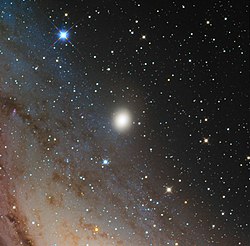Messier 32
Messier 32 (also known as NGC 221) is a dwarf "early-type" galaxy about 2.65 million light-years from Earth. It is seen in the constellation Andromeda.
M32 is a satellite galaxy of the large Andromeda Galaxy (M31). It was discovered by Guillaume Le Gentil in 1749. M32 measures 6.5 ± 0.2 thousand light-years in diameter at the widest point.[1]
The galaxy is a compact elliptical galaxy type. Compact ellipticals are rather rare. Half the stars are inside an effective radius of only 100 parsecs.[2][3]
Densities in the central area increase steeply, over 3×107 M⊙ pc−3 as seen by the HST.[4] The half-light radius of this central star cluster is around 6 parsec.[5] In other words, this small centre of the galaxy emits half the light of the central 100 parsecs.
Like more ordinary elliptical galaxies, M32 contains mostly older faint red and yellow stars with practically no dust or gas and consequently no current star formation.[6] It does, however, show hints of star formation in the relatively recent past. [7][8]
M32 contains a supermassive black hole. Its mass is between 1.5 and 5 million solar masses.[9]
It is believed by astronomers that Messier 32 is the remnant of the former galaxy in the local group called M32p.
Messier 32 Media
References
- ↑ Diameter = distance × sin(diameter_angle) = 6.5 ± 0.2 thousand light-years. diameter
- ↑ Kent S.M. (1987). "Surface photometry of six local group galaxies". Astronomical Journal. 94: 306–314. Bibcode:1987AJ.....94..306K. doi:10.1086/114472.
- ↑ Mateo M.L. (1998). "Dwarf Galaxies of the Local Group". Annual Review of Astronomy and Astrophysics. 36: 435–506. arXiv:astro-ph/9810070. Bibcode:1998ARA&A..36..435M. doi:10.1146/annurev.astro.36.1.435. S2CID 119333888.
- ↑ Lauer T.R.; et al. (1992). "Planetary camera observations of the central parsec of M32". Astronomical Journal. 104: 552–562. Bibcode:1992AJ....104..552L. doi:10.1086/116254. Archived from the original on 2022-05-17. Retrieved 2022-02-22.
- ↑ Graham A.W. and Spitler L.R. Quantifying the coexistence of massive black holes and dense nuclear star clusters
- ↑ Kepple, George Robert; Sanner, Glen W. (1998). The Night Sky Observer's Guide. Vol. 1. Willmann-Bell. p. 17. ISBN 0-943396-58-1.
- ↑ Rudenko, Pavlo; Worthey, Guy; Mateo, Mario (2000). "Intermediate age clusters in the field containing M31 and M32 stars". The Astronomical Journal. 138 (6): 1985–1989. Bibcode:2009AJ....138.1985R. doi:10.1088/0004-6256/138/6/1985. S2CID 120718867.
- ↑ Armando, Gil de Paz; et al. (2007). "The GALEX Ultraviolet Atlas of Nearby Galaxies". Astrophysical Journal Supplement. 173 (2): 185–255. arXiv:astro-ph/0606440. Bibcode:2007ApJS..173..185G. doi:10.1086/516636. S2CID 119085482.
- ↑ Tonry J.L. (1984). "Evidence for a central mass concentration in M32". Astrophysical Journal Letters. 283: L27. Bibcode:1984ApJ...283L..27T. doi:10.1086/184326.



